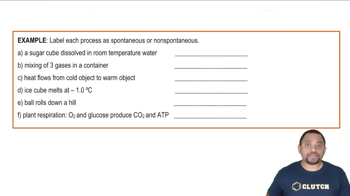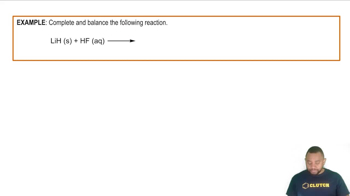When iron rusts, solid iron reacts with gaseous oxygen to form solid iron(III) oxide. Write the balanced chemical equation for this reaction.
Ch.4 - Chemical Reactions and Chemical Quantities

Chapter 4, Problem 18
Write the balanced equation for the photosynthesis reaction in which gaseous carbon dioxide and liquid water react in the presence of chlorophyll to produce aqueous glucose (C6H12O6) and oxygen gas.
 Verified step by step guidance
Verified step by step guidance1
Write the unbalanced chemical equation for the photosynthesis reaction: \( \text{CO}_2 (g) + \text{H}_2\text{O} (l) \rightarrow \text{C}_6\text{H}_{12}\text{O}_6 (aq) + \text{O}_2 (g) \)
Balance the carbon atoms: Since there are 6 carbon atoms in glucose (\(\text{C}_6\text{H}_{12}\text{O}_6\)), you need 6 \(\text{CO}_2\) molecules.
Balance the hydrogen atoms: Glucose has 12 hydrogen atoms, so you need 6 \(\text{H}_2\text{O}\) molecules to provide these hydrogen atoms.
Balance the oxygen atoms: Count the total oxygen atoms on both sides and adjust the \(\text{O}_2\) molecules to balance them.
Verify that all elements are balanced: Ensure that the number of atoms for each element is the same on both sides of the equation.
Key Concepts
Here are the essential concepts you must grasp in order to answer the question correctly.
Photosynthesis
Photosynthesis is the biochemical process by which green plants, algae, and some bacteria convert light energy into chemical energy. This process primarily occurs in the chloroplasts of plant cells, where chlorophyll captures sunlight to drive the conversion of carbon dioxide and water into glucose and oxygen. The overall reaction is essential for producing the organic compounds that serve as food for the plant and, indirectly, for other organisms.
Recommended video:
Guided course

Spontaneity of Processes Example
Chemical Equation Balancing
Balancing a chemical equation involves ensuring that the number of atoms for each element is the same on both the reactant and product sides. This is based on the law of conservation of mass, which states that matter cannot be created or destroyed in a chemical reaction. Balancing is crucial for accurately representing the stoichiometry of the reaction, which indicates the proportions of reactants and products involved.
Recommended video:
Guided course

Balancing Chemical Equations
Reactants and Products
In a chemical reaction, reactants are the starting substances that undergo a transformation, while products are the substances formed as a result of the reaction. In the context of photosynthesis, the reactants are carbon dioxide (CO2) and water (H2O), and the products are glucose (C6H12O6) and oxygen (O2). Understanding the roles of reactants and products is fundamental to writing and interpreting chemical equations.
Recommended video:
Guided course

Production of Hydrogen Example
Related Practice
Textbook Question
Textbook Question
Write the balanced chemical equation for the fermentation of sucrose (C12H22O11) by yeasts in which the aqueous sugar reacts with water to form aqueous ethanol (C2H5OH) and carbon dioxide gas.
Textbook Question
Write the balanced chemical equation for each reaction. a. Solid lead(II) sulfide reacts with aqueous hydrobromic acid to form solid lead(II) bromide and dihydrogen monosulfide gas.
Textbook Question
Write the balanced chemical equation for each reaction. b. Gaseous carbon monoxide reacts with hydrogen gas to form gaseous methane (CH4) and liquid water.
Textbook Question
Write the balanced chemical equation for each reaction. c. Aqueous hydrochloric acid reacts with solid manganese(IV) oxide to form aqueous manganese(II) chloride, liquid water, and chlorine gas.
1
views
